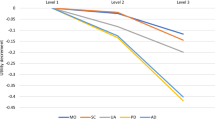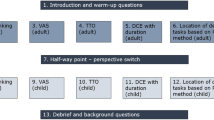Abstract
Objectives
In contrast to the proliferation of studies incorporating health state values from adults of all ages, relatively few studies have reported upon the application of the time trade off (TTO) approach to generate health state values from populations of younger adults. This study sought to employ a conventional TTO approach to obtain values for a selection of Child Health Utility 9D (CHU9D) health states from a sample of young adults aged 18–29 years and to compare with the values generated from application of the original UK adult standard gamble scoring algorithm and the Australian adolescent scoring algorithm.
Methods
A convenience sample of Flinders University undergraduate students aged 18–29 years were invited to participate in an interviewer administered conventional TTO task to value a series of five CHU9D health impairment states using the widely used variant developed by the York EQ-5D team.
Results
A total of 152 students within the target age range were approached to participate in the study of whom n = 38 consented to participate, giving an overall participation rate of 25 %. With the exception of one health state, the mean TTO values were consistently lower than those generated from application of the original scoring algorithm for the CHU9D elicited with adults of all ages. A significant proportion of participants (n = 17, 45 %) considered the most severe CHU9D (PITS) state to be worse than death.
Conclusions
This study adds to a growing body of evidence indicating that the values attached to identical health states are typically lower for younger people in comparison with adults of all ages and dependent upon the elicitation method utilised. The values obtained are applicable for re-scaling raw CHU9D health state values obtained from younger adolescent samples using profile case best-worst scaling.
Similar content being viewed by others
References
Stevens K. Developing a descriptive system for a new preference-based measure of health related quality of life for children. Qual Life Res. 2009;18:1105–13.
Williams P, Holmbeck G, Greenley R. Adolescent health psychology. J Consult Clin Psychol. 2002;2002(70):828–42.
Ratcliffe J, Stevens K, Flynn T, Brazier J, Sawyer M. Whose values in health? An empirical comparison of the application of adolescent and adult values for the CHU9D and AQOL-6D in the Australian adolescent general population. Value Health. 2012;15(5):730–6.
Ratcliffe J, Flynn T, Terlich F, Brazier J, Stevens K, Sawyer M. Developing adolescent specific health state values for economic evaluation: an application of profile case best worst scaling to the Child Health Utility-9D. Pharmacoeconomics. 2012;30(8):713–27.
Stevens K, Ratcliffe J. Measuring and valuing health benefits for economic evaluation in adolescence: an assessment of the practicality and validity of the Child Health Utility 9D in the Australian adolescent population. Value Health. 2012;15(8):1092–9.
Ratcliffe J, Stevens K, Flynn T, Brazier J, Sawyer M. An assessment of the construct validity of the CHU9D in the Australian adolescent general population. Qual Life Res. 2012;21(4):717–25.
Stevens K. Valuation of the Child Health Utility 9D Index. Pharmacoeconomics. 2012;30:729–47.
Flynn T, Louviere J, Marley A, Peters T, Coast J. Rescaling quality of life tariffs from discrete choice experiments for use as QALYs: a cautionary tale. Popul Health Metr. 2008;6:6.
Ratcliffe J, Couzner L, Flynn T, Sawyer M, Stevens K, Brazier J, Burgess L. Valuing Child Health Utility 9D health states with a young adolescent sample: a feasibility study to compare best-worst scaling discrete-choice experiment, standard gamble and time trade-off methods. Appl Health Econ Health Policy. 2011;9(1):15–27.
Brazier J, Ratcliffe J, Salomon J, Tsuchiya A. Measuring and valuing health benefits for economic evaluation. Oxford: Oxford University Press; 2007.
Torrance GW. Social preferences for health states: an empirical evaluation of three measurement techniques. Socio-Econ Plan Sci. 1976;1976(10):129–36.
Augustovski F, Rey-Ares L, Irazola V, Oppe M, Devlin NJ. Lead versus lag-time trade-off variants: does it make any difference? Eur J Health Econ. 2013;14(Suppl 1):S25–31.
Dolan P, Gudex C, Kind P, Williams A. The time trade-off method: results from a general population study. Health Econ. 1996;5:141–52.
Anderson A, Krølner R, Currie C, Dallago L, Due P, Richter M, Orkényi A, Holstein BE. High agreement on family affluence between children and parents’ self-reports. J Epidemiol Community Health. 2008;62:1092–4.
StataCorp LP (2011). Intercooled stata 12.1 for windows. College station, Texas: StataCorp LP.
Rowen D, Brazier J, Van Hout B. A comparison of methods for converting DCE values onto the full health-dead QALY scale. Med Decis Making. 2015;35:328–40.
Tong A, Tjaden L, Howard K, Wong G, Morton R, Craig J. Quality of life of adolescent kidney transplant recipients. J Pediatr. 2011;159:670–5.
Yi MS, Britto MT, Wilmott RB, Kotagal UR, Eckman MH, Nielson DW, et al. Health values of adolescents with cystic fibrosis. J Pediatr. 2003;142:133–40.
De Luca C, Wood S, Anderson V, Buchanan J, Proffitt T, Mahony K, Pantelis C. Normative data from the Cantab. I: development of executive function over the lifespan. J Clin Exper Neuropsychol. 2003;25:242–54.
Romine C, Reynolds C. A model of the development of frontal lobe functioning: findigns from a meta-analysis. Appl Neuropsychol. 2005;12:190–201.
Bleichrodt H. A new explanation for the difference between time trade-off utilities and standard gamble utilities. Health Econ. 2002;11:447–56.
Gunning JP. Understanding democracy: an introduction to public choice. Taiwan: Nomad Press; 2003.
Acknowledgments
We would like to express our gratitude to the Flinders University students who generously gave up their time to participate in this study. This study was supported by a Flinders University seeding grant and an Australian NHMRC Project Grant 1021899 entitled ‘Adolescent values for the economic evaluation of adolescent health care treatment and preventive programs’.
Author contributions
All authors contributed to the design of the study and JR wrote the draft manuscript with input from all authors. LC and SB conducted the TTO interviews and collected the data. GC analysed the data with assistance from JR and KS. All authors provided critical review of the manuscript and final approval of the version to be submitted for publication. JR is the guarantor for the overall content.
Author information
Authors and Affiliations
Corresponding author
Ethics declarations
This study was supported by a Flinders University seeding grant and an Australian NHMRC Project Grant 1021899 entitled ‘Adolescent values for the economic evaluation of adolescent health care treatment and preventive programs’. There are no conflicts of interests for any of the authors (Julie Ratcliffe, Gang Chen, Katherine Stevens, Sandra Bradley, Leah Couzner, John Brazier, Michael Sawyer, Rachel Roberts, Elisabeth Huynh, Terry Flynn). This study was approved by the Flinders University Social and Behavioural Research Ethics Committee (project no: 6347) and has been performed in accordance with the ethical standards of the Declaration of Helsinki. Informed consent was obtained from all participants included in the study.
Appendix
Rights and permissions
About this article
Cite this article
Ratcliffe, J., Chen, G., Stevens, K. et al. Valuing Child Health Utility 9D Health States with Young Adults: Insights from a Time Trade Off Study. Appl Health Econ Health Policy 13, 485–492 (2015). https://doi.org/10.1007/s40258-015-0184-3
Published:
Issue Date:
DOI: https://doi.org/10.1007/s40258-015-0184-3




